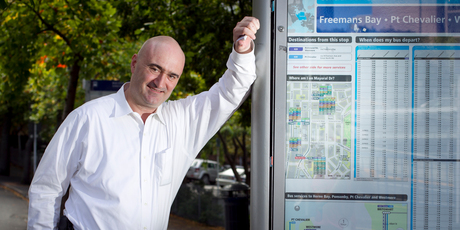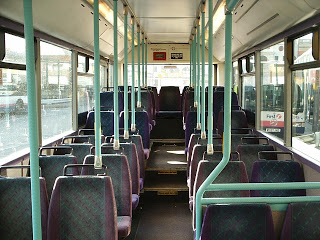Jarrett Walker: Empty Buses Serve a Purpose
12:54 PM EDT on August 14, 2013
Most transit agencies have been through some version of this scenario: In one part of the city, buses drive around stuffed like sardine tins, while elsewhere they can be all but empty. Car drivers mock the empty buses in low-density parts of the city. Some elected official picks up the banner, demanding that the transit agency stop flagrantly wasting taxpayer money by running these money-losing routes.

If you hear echoes of the federal fight over Amtrak, you’re not going crazy -- it’s the exact same conversation.
And it merits the exact same answer.
Ridership versus coverage
As transit consultant Jarrett Walker, the mind behind the Human Transit book and blog, sees it, every transit agency needs to make a trade-off between ridership and coverage. The agency can focus on routes with high ridership -- which makes the most sense environmentally and financially -- but then large swaths of the area will have no service at all. It simply doesn’t make fiscal sense to serve low-density areas, or areas without a complementary pedestrian network, with transit. Not enough people will ride it.
But if you cut that service, you’ve cut off a lifeline to people with disabilities, seniors with no other transportation options, people with low incomes, and others. “Social benefits of public transport, such as accessibility for persons who cannot drive, tend to be based on the severity of need among certain population groups, rather than the level of patronage to be gained by meeting this need,” Walker wrote in a 2008 paper in the Journal of Transport Geography. The people served by a low-ridership route might not be populous enough to make a route through a low-density area particularly profitable, but the service is still valuable. It serves a goal of coverage, not ridership.
Walker encourages transit agencies to have the ridership-versus-coverage conversation publicly and without shame. They should decide upfront, with community input, what percentage of their resources will be spent on routes with high ridership and what percentage will be devoted to broadening the geographical reach of coverage outside those high-ridership zones.
These conversations are becoming more and more essential as tight budgets and limited federal funding are bringing more scrutiny to transportation spending. Although transit agencies are generally serving more riders with less money, they are constantly asked to prove that they’re not wasting taxpayer funds. “One of the ways you can answer that kind of public demand is to have the ridership/coverage conversation,” Walker told Streetsblog, “because to the ordinary suburban voter’s mind, an empty bus driving around their subdivision looks like government waste. They don’t understand that it’s actually the result of conscious policy, namely a coverage policy, and that their own city leaders may have been fighting hard for that policy.”
“There’s a lot of confusion out there, and unfortunately there a lot of economic intellectuals out there who are writing articles that make it sound like because transit systems run empty buses that means they’re failing -- just not understanding what transit agencies are actually expected to do,” Walker said. “Those buses are valued for the lifeline access they provide for the isolated senior.”
Coverage service isn’t just about social equity and serving the poor and down-trodden, either. It can also seek to include suburban routes in affluent areas where most people have cars but their taxes help fund the transit service. Sometimes “equity” just means making sure everyone who pays in at least has the option of using the system, whether they do or not.
“Its benefits arise from its sheer existence.”
The goals of the two kinds of service are distinct, Walker explains. A ridership goal is one that is met when more people use transit. “VMT reduction is one of several goals that arise from transit being used rather than from transit just existing,” he said. “And that’s fundamentally the difference. Coverage service: its benefits arise from its sheer existence.”
High-ridership routes, which are the emissions-reducing powerhouses of transit, can support frequent service all day long or at least at peak times. “Coverage” routes don’t solve any environmental problems but do address social and geographic equity, and the service tends to be of poorer quality: infrequent and circuitous. Success in coverage is measured by determining what percentage of residents and jobs are within a certain distance of transit service. Those numbers need to be filled in by the transit agency setting the goal.
Once that goal is set -- ideally in consultation with the public -- transit agencies have a transparent and easy reply to constituents angry about cuts to low-ridership service. Rather than debate the benefits of that particular transit service, those people would need to lobby for a change in the ratio of ridership-to-coverage.
Setting clear priorities around coverage and ridership service was helpful for the transit agency in Reno, Nevada, where Walker served as a consultant. “There’s always been a difficult conversation about bus routes that go out into [semi-rural] territory, because the ridership is always dreadful, because you have to drive such a long distance to get to a relatively few people,” Walker said. “And yet you have people who have fairly limited options that end up aging in place in a mobile home out in the desert.”
Value judgments
Reno decided to go with an 80 percent ridership to 20 percent coverage split. It’s the most lopsided Walker said he’s seen, but he never makes recommendations on numbers. “I’m very suspicious whenever something that is presented as technical analysis contains value judgments,” he said. “You don’t want me as a consultant to fly in to your community and tell you who you are and what you want your transit system to be. Ridership versus coverage is one of those questions that’s designed to bring out the community’s own values. It has no technical answer.”
The distinction between ridership lines and coverage lines may fall into a gray area, too. “It may very well be that an existing route is 50/50,” Walker said. “It might be that geographically half the route is coverage and half of the route is ridership. In some cases, there might be a route that has good land use patterns, good indicators of high ridership, but that has lousy ridership because it doesn’t have enough service.” He said he considers Robertson Boulevard in Los Angeles to be a ridership line, even though it has low ridership, because well located to be a booming route -- if only it ran more than every hour.
Another reason that a sparsely-used line could be a “ridership” route is that it may be leading development. “You may be in an area that is growing rapidly,” Walker said. “And you may be intentionally running a low-ridership service in anticipation that if certain things get built it’s going to be a high-ridership service.”
“Urban developers are always hassling us to run service in advance of development, to get service out there right away to form transit habits,” he said. “And that’s one of the reasons we run empty buses around in suburban areas, waiting for things to get built.”
Stay in touch
Sign up for our free newsletter
More from Streetsblog USA
‘We Don’t Need These Highways’: Author Megan Kimble on Texas’ Ongoing Freeway Fights
...and what they have to teach other communities across America.
Should Wednesday’s Headlines 86 SUVs?
American tax law encourages people to buy the gas-guzzling and deadly vehicles, but some in Canada are pushing to ban them.
Brightline West Breaks Ground on Vegas to SoCal High-Speed Rail
Brightline West will be a 218-mile 186-mile-per-hour rail line from Vegas to Rancho Cucamonga — about 40 miles east of downtown L.A. — expected to open in 2028.
Tuesday’s Headlines Fix It First
How voters incentivize politicians to ignore infrastructure upkeep. Plus, are hydrogen trains the future of rail or a shiny distraction?
Why We Can’t End Violence on Transit With More Police
Are more cops the answer to violence against transit workers, or is it only driving societal tensions that make attacks more frequent?





